- There are no more items in your cart
- Shipping Calculated at checkout
-
Sub-Total (inc. VAT)
£0.00
Need Help?
Decking Paints and Coatings
Decking is a versatile and attractive feature for many UK properties, enhancing both the functionality and aesthetic appeal of outdoor spaces. Whether used in domestic gardens, commercial areas, public sector facilities, or industrial settings, decking paint is crucial in maintaining and improving these areas. This category covers everything required for researching, buying and applying waterproofing coatings for all decking types, styles, locations, maintenance, colour options, trends, and more, providing product recommendations from Osmo, Owatrol, Coo-Var, and Blackfriar. Click for more info.
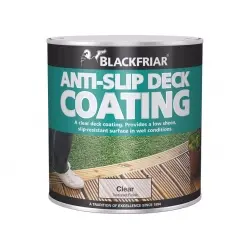
Blackfriar Anti-Slip Deck Coating
Blackfriar Anti-Slip Deck Coating provides all types of exterior timber decking and walkways with a protective, slip-resistant surface. Containing micro-aggregates for added safety, this coating gives increased grip in wet conditions while allowing the beauty of wood to show through. Provides a slip-resistant surface in wet conditions...
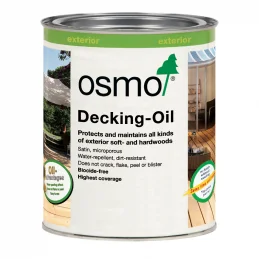
Osmo Decking-Oil
Osmo Decking-Oils meet the demands of wooden decking with a variety of colours and unsurpassed durability for all weather conditions. Protect and maintain timber, decking, garden furniture and privacy screens made of numerous coniferous and fine woods. Also suitable as a transparent colour treatment of Teak, Eucalyptus and other fine woods...
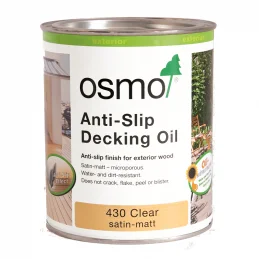
Osmo Anti-Slip Decking Oil
Osmo Anti-Slip Decking Oil, a clear slip-resistant top coat for exterior timber decking and stairs in outdoor areas already treated with coloured Osmo oils, for ribbed, grooved, and particularly for smooth decking surfaces. Natural wood character remains visible - Highly water and dirt resistant Active ingredients protect the coating...

Coo-Var Suredeck Anti Slip Decking Protector
Clear water-based, UV-resistant coating. For tanalised, softwood, and hardwood decking surfaces. Creates a low-slip risk surface. Exterior use. Non-flammable.
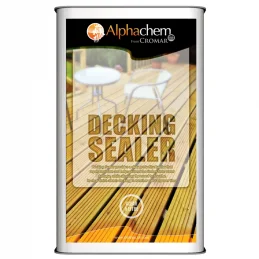
Cromar Decking Sealer
Cromar Decking Sealer is a quality clear sealer formulated to provide an effective water repellent barrier for the protection of timber decking. A test patch is always recommended, prior to use to ensure desired result is achieved Will waterproof and protect any smooth or ridged, hardwood or softwood decking timber Including...
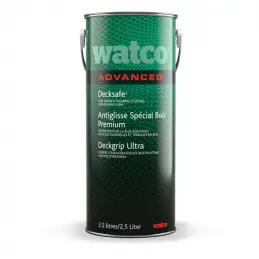
Watco Decksafe Advanced
The ultimate protective coating for decking, an ultra durable non slip finish that prolongs the life of timber decking, pontoons, and more. Only one coat required Easy to apply, 3-component product Resists UV fading and discolouration, flexible to resist cracking Flexible, two part polyaspartic resin Excellent slip resistance. PTV (wet)...
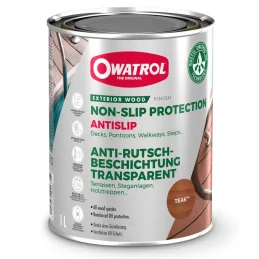
Owatrol Antislip Non-Slip Protection
Provides an anti-slip surface for pedestrian traffic and a skid resistant surface for wheeled traffic. For decks and decking, docks, pontoons, steps, walkways and more. Exterior use on horizontal wood surfaces. For new or weathered timber, planed or rough-sawn - all wood species. Produces a more evenly textured surface than conventional...
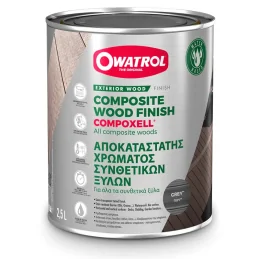
Owatrol Compoxell Composite Wood Finish
Semi-transparent water-base finish for decorating and restoring all composite woods - decks, cladding, garden furniture etc. Ideal for grooved decking. Hardwearing. Stain resistant. Waterproofing.
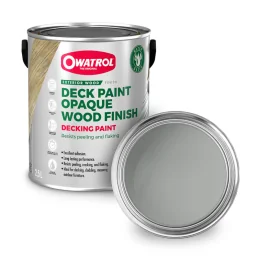
Owatrol Decking Paint Opaque Wood Finish
Premium finish in 35 opaque shades for new wood and for recoating old applications. Delivers high traffic performance on deck surfaces and perfect choice for long-lasting beauty on sidings. Paint sidings, trim boards, and garden furniture from the same tin. 5 years warranty against peeling on decking and 15 years on cladding against...
Need Help?
Need Help?
The History of Decking in the UK
Early Beginnings
Decking as a distinct outdoor architectural feature has a relatively modern history in the UK. Unlike countries such as the United States and Australia, where decking became popular in the mid-20th century, the adoption of decking in the UK began to gain momentum later, around the 1980s. Prior to this period, UK gardens traditionally featured stone patios and lawns, with wooden structures primarily used for garden sheds and fences.
Influences and Early Adoption
The trend towards decking in the UK was significantly influenced by American and Australian lifestyles, showcased through media and increased travel. British homeowners started to appreciate the versatility and aesthetic appeal of wooden decks, viewing them as an extension of their indoor living spaces. Decking allowed for a practical yet stylish area for outdoor entertainment, which resonated with the growing desire for leisure-oriented garden designs.
1980s to 1990s: The Rise of Decking
In the 1980s and 1990s, decking saw a surge in popularity in the UK. This period marked a cultural shift towards more casual and functional outdoor living. Television programs and gardening magazines played a crucial role in promoting decking as a fashionable garden feature. Shows such as "Ground Force" with Alan Titchmarsh showcased impressive garden transformations, often incorporating decking as a key element. The DIY culture was also on the rise, and decking kits became readily available at garden centers and home improvement stores, making it easier for homeowners to install their own decks.
Introduction of Paints, Stains, and Oils
With the rise of decking, the need to maintain and protect wooden structures became apparent. In the late 1980s and early 1990s, paints, stains, and oils specifically designed for decking started to gain popularity in the UK. These products provided homeowners with options to preserve the wood, enhance its appearance, and extend its lifespan.
Paints: Decking paints offered a way to add colour and personality to outdoor spaces. They provided a durable layer of protection against the elements, helping to prevent moisture penetration and wood rot. Paints became especially popular for those wanting to match their decks with the aesthetic of their homes and gardens.
Stains: Decking stains allowed the natural grain of the wood to show through while providing protection. Stains penetrated the wood fibres, offering a semi-transparent finish that enhanced the wood's natural beauty. They came in various shades, from light to dark, enabling homeowners to achieve their desired look while safeguarding the timber from UV damage and weathering.
Oils: Decking oils were valued for their ability to nourish and protect the wood from within. Oils penetrated deeply into the timber, replenishing its natural oils and providing a rich, lustrous finish. They were particularly effective in preventing the wood from drying out, cracking, and splitting. Oils also enhanced the natural colour and grain of the wood, making them a popular choice for preserving the authentic look of timber decks.
2000s: Peak Popularity and Innovation
The early 2000s marked the peak of decking's popularity in the UK. Advances in materials and treatments expanded the choices available to consumers, with pressure-treated timber becoming a standard for durability. Composite decking, made from a mixture of wood fibres and plastic, emerged as a low-maintenance alternative to traditional wood, offering resistance to rot, splintering, and insect damage.
During this time, decking was no longer seen just as an addition to a garden but as a focal point for outdoor activities. The introduction of various design elements such as integrated lighting, built-in seating, and planters helped to elevate the functionality and aesthetic of garden decks.
Recent Trends and Sustainable Practices
In recent years, the decking industry in the UK has continued to evolve, with an increasing emphasis on sustainability and eco-friendly materials. The demand for responsibly sourced timber and environmentally friendly composites has grown, reflecting broader environmental concerns and regulations. Innovations in decking materials, such as bamboo decking and recycled composites, have also gained traction.
Moreover, contemporary designs now focus on blending decks seamlessly with natural surroundings, often incorporating biophilic design principles to enhance the connection between indoor and outdoor spaces. This trend aligns with the modern desire for sustainable living and the creation of multifunctional outdoor areas.
Types of Decking
Timber Decking: Made from various wood types such as cedar, redwood, and pressure-treated pine, timber decking offers a natural look but requires regular maintenance to prevent rot and decay. It is known for its strength and classic appearance.
Composite Decking: Comprising wood fibres and recycled plastic, composite decking is low-maintenance and resistant to rot and insect damage. It comes in various colours and textures and mimics the appearance of natural wood while providing greater durability.
Styles and Locations
Domestic Use:
Gardens and Patios: Decking provides an elegant and functional outdoor space for dining, relaxation, and entertainment. It's a great way to level uneven ground and create a usable surface.
Balconies and Roof Terraces: Decking maximises outdoor space in urban environments, creating comfortable areas for leisure. It’s particularly popular in city apartments.
Swimming Pools and Hot Tubs: Non-slip decking around water features ensures safety while enhancing aesthetics. The use of water-resistant finishes is crucial here.
Commercial Use:
Retail Areas: Decking in shopping centres and retail parks creates inviting outdoor spaces for shoppers, often used for seating areas, walkways, and display platforms. It enhances the customer experience by offering pleasant and practical spaces.
Cafés, Bars, and Restaurants: Decking enhances outdoor dining areas, creating pleasant environments for customers. It allows businesses to expand their seating capacity and appeal to customers who enjoy al fresco dining.
Hotels and Resorts: Decking around pools and communal areas adds luxury and comfort, providing guests with attractive outdoor spaces. It also helps in defining spaces and guiding foot traffic.
Public Sector Use:
Parks and Recreation Areas: Durable and safe decking solutions for public use, offering recreational and aesthetic benefits. Decking is often used for boardwalks and viewing platforms in nature reserves.
Schools and Playgrounds: Decking provides clean, safe, and durable surfaces for outdoor activities, enhancing the usability of these spaces. Anti-slip finishes are particularly important here for safety.
Industrial Use:
Factories and Warehouses: While less common, timber or composite decking might be used in certain light industrial settings, especially where aesthetics matter, such as in factory visitor centres or employee break areas.
Product Recommendations
Osmo Decking Paints:
- Osmo Decking-Oil: Enhances the natural appearance of timber decking while providing protection. Available in various shades, it highlights the wood grain and ensures durability.
- Osmo Anti-Slip Decking Oil: Ideal for high-traffic areas, this oil provides an anti-slip surface while maintaining the wood's natural look.
Coo-Var Decking Paints:
- Coo-Var Anti-Slip Decking Paint: Suitable for domestic and commercial use, offering a durable, anti-slip finish that enhances safety.
- Coo-Var Decking Sealer and Protector: Protects decking from the elements and enhances its appearance, prolonging its lifespan.
Blackfriar Decking Paints:
- Blackfriar Anti-Slip Deck Coating: Provides a tough, durable finish with excellent anti-slip properties, suitable for both commercial and domestic applications.
- Blackfriar UV Wood Protector: Protects wood from UV damage while enhancing its natural beauty, ensuring long-lasting protection and appearance.
Maintenance
Proper maintenance is crucial to ensure the longevity and appearance of decking. This includes:
Regular Cleaning: Regularly clean the decking to remove dirt, algae, and mould. Use appropriate cleaning products to avoid damaging the surface. Pressure washing can be effective but should be done with care to avoid damaging the wood.
Repainting or Re-staining: Depending on the type of decking paint or stain used, you may need to reapply every 1-3 years. Always follow the manufacturer’s guidelines for the best results.
Repairs: Promptly repair any damaged or loose boards to prevent accidents and further deterioration. This includes fixing nails or screws that have popped up and replacing any split or rotting boards.
Seasonal Checks: Inspect your decking at least twice a year, in spring and autumn, to check for any damage or wear and prepare it for the coming season.
Colour Options, Trends, and Styles
Decking paints come in a wide range of colours, from natural wood tones to vibrant hues. Current trends include:
Natural and Earthy Tones: Browns, greys, and greens that blend seamlessly with garden environments, providing a classic and harmonious look.
Bold Colours: Reds, blues, and yellows for a striking, modern appearance that can make your decking a focal point.
Monochrome: Black and white decking for a contemporary, minimalist style, often used in urban settings for a sleek look.
Health and Safety Guidelines
Domestic Use:
Anti-Slip Surfaces: Use anti-slip coatings to prevent accidents, especially in areas prone to moisture like around pools or in shaded areas.
Proper Installation: Ensure that the decking is properly installed with no loose boards or protruding nails/screws to prevent injuries.
Regular Maintenance: Keep the decking clean and free of algae and moss, which can make the surface slippery.
Commercial and Public Sector Use:
Compliance with Standards: Ensure that decking meets health and safety standards, including anti-slip ratings and structural integrity requirements.
Regular Inspections: Conduct regular inspections to identify and rectify potential hazards such as loose boards or slippery surfaces.
Adequate Lighting: Ensure that decking areas are well-lit to prevent trips and falls, particularly in evening or night-time settings.
Improving the Slip Resistance of Decking
Slip resistance is a crucial factor in the safety of decking, particularly in high-traffic or wet areas. Here are some methods to improve the slip resistance of your decking:
Anti-Slip Coatings: Products like Coo-Var Anti-Slip Decking Paint and Osmo Anti-Slip Decking Oil add a textured surface that enhances grip and reduces the risk of slipping. These coatings are easy to apply and provide a durable, long-lasting solution.
Grip Strips: Installing grip strips or anti-slip treads on high-traffic areas can provide additional traction. These strips are available in various materials, including rubber and metal, and can be easily attached to the decking surface.
Textured Finishes: Opting for decking with a naturally textured surface, such as grooved or ribbed boards, can improve slip resistance. Composite decking often comes with these features, providing both aesthetic and safety benefits.
Regular Cleaning: Keeping the decking clean from dirt, algae, and leaves can significantly reduce the risk of slipping. Use a deck cleaner and a brush to maintain a clean surface, especially in shaded or damp areas.
Sand Additives: Adding sand or grit to the final coat of paint or stain can create a rougher surface that improves traction. This method is simple and cost-effective, particularly for DIY projects.
Decking Paint FAQs
What is the difference between decking paint, stain, and varnish?
- Decking Paint: Provides a solid, opaque colour that hides the wood grain and imperfections. It forms a protective layer over the wood, offering robust protection against the elements but may require more maintenance as it can peel or chip over time.
- Decking Stain: Available in various transparency levels, decking stain penetrates the wood, highlighting its natural grain while providing protection. It tends to be more durable than paint as it doesn’t form a surface film that can peel off.
- Varnish: Usually clear, varnish offers a glossy finish that enhances the wood's natural beauty. It forms a hard, protective surface but can be prone to cracking and peeling in outdoor conditions, making it less suitable for decking compared to oils or stains.
How often should I repaint my decking?
Repainting frequency depends on the type of paint and environmental conditions. Generally, decking paint should be reapplied every 1-3 years to maintain its appearance and protective qualities. High-traffic areas may require more frequent maintenance.
Can I paint over existing decking paint?
Yes, but proper surface preparation is essential. Clean the surface thoroughly, sand any peeling or flaking paint, and ensure the new paint is compatible with the old. Applying a primer can improve adhesion and longevity.
What is the best decking paint for anti-slip properties?
Coo-Var Anti-Slip Decking Paint and Osmo Anti-Slip Decking Oil are highly recommended for their durable and effective anti-slip finishes, making them ideal for both domestic and commercial use.
How do I prepare my decking for painting?
Begin by cleaning the decking to remove dirt, algae, and old coatings. Use a deck cleaner or a mild detergent. Sand the surface to remove any peeling paint and to smooth out rough areas. Ensure the decking is dry before applying the paint. Applying a primer may be necessary, depending on the paint used.
Can decking paint be used on composite decking?
Some decking paints are formulated specifically for use on composite decking. It’s essential to check the manufacturer’s recommendations and ensure the surface is properly prepared for paint adhesion.
What colours are available for decking paint?
Decking paints come in a wide range of colours, including natural wood tones like cedar, oak, and teak, as well as contemporary shades like grey, white, black, and various bold colours for a modern look.
How do I maintain the colour of my decking?
Regular cleaning and the application of UV-protective coatings can help maintain the decking’s colour. Reapplying paint or stain every few years, as per manufacturer instructions, will also keep it looking fresh and vibrant.
Is it necessary to seal decking after painting?
While some decking paints include sealing properties, applying an additional sealant can enhance durability and protection, especially in areas exposed to harsh weather conditions.
What is the best time of year to paint decking?
The best time is during dry, mild weather, typically in late spring or early autumn. Avoid painting in direct sunlight or when rain is forecast to ensure proper drying and curing.
How long does decking paint take to dry?
Drying times vary by product but typically range from a few hours to 24 hours. Check the manufacturer’s instructions for specific drying and curing times to ensure the best results.
Can I use decking paint on other outdoor wood surfaces?
Yes, many decking paints can be used on other outdoor wood surfaces such as fences, sheds, and garden furniture. Always check the product specifications for compatibility.
How do I remove old decking paint?
Use a paint stripper or a deck cleaner, followed by sanding to remove any remaining paint and smooth the surface. For large areas, a pressure washer can be used, but care should be taken to avoid damaging the wood.
What are the benefits of using decking paint over stain?
Decking paint offers a broader range of colours and provides a more uniform appearance. It can cover imperfections in the wood and offers robust protection against the elements, making it suitable for high-traffic areas.
Are there eco-friendly decking paint options?
Yes, many brands offer eco-friendly decking paints with low VOC (Volatile Organic Compounds) that are less harmful to the environment and safer for use in residential areas.
How do I prevent mould and algae on my decking?
Regular cleaning and using mould and algae-resistant paints or stains can help prevent growth. Ensure proper drainage to avoid water pooling and consider applying a mildew-resistant sealant.
What is the lifespan of decking paint?
The lifespan varies by product and conditions but generally ranges from 1-3 years for regular paint and up to 5 years for high-quality options. Regular maintenance can extend the lifespan.
Can I use a pressure washer on painted decking?
Yes, but use a low-pressure setting to avoid damaging the paint. Regular cleaning with a mild detergent and a soft brush can also effectively maintain the decking without harming the finish.
How do I choose the right decking paint colour?
Consider the existing landscape, the desired aesthetic, and the amount of sunlight the area receives. Testing samples before committing to a colour can help ensure you choose the right shade for your space.
What are the common problems with decking paint and how to fix them?
- Peeling: Often caused by improper surface preparation or moisture. Fix by sanding the peeling areas and repainting with a compatible primer and paint.
- Fading: Due to UV exposure. Reapply UV-protective paint or stain to restore colour.
- Cracking: From weather changes or improper application. Use a flexible, weather-resistant paint and ensure proper application techniques.
Different Requirements of Decking Based on Location in the UK
Coastal Areas: Decking in seaside locations needs to withstand high salt content and moisture. Using weather-resistant and anti-corrosive paints and finishes is essential. Regular maintenance is also crucial to prevent rot and decay.
Urban Areas: Decking in cities often faces pollution and heavy foot traffic. Durable, anti-slip finishes are necessary, along with frequent cleaning and maintenance to keep the decking safe and visually appealing.
Rural Areas: Decking in countryside locations may be exposed to varying weather conditions and wildlife. Using robust, weather-resistant paints and performing regular inspections and maintenance can help preserve the decking.
Wet and Shaded Areas: Locations with high moisture levels or constant shade require anti-fungal and anti-algae treatments to prevent growth and ensure safety.
The information provided above is a basic overview and is intended as general information only. It is not advice, and is given without warranty. You should always refer to the relevant data sheets and our Technical Team prior to purchase or use of any products.
